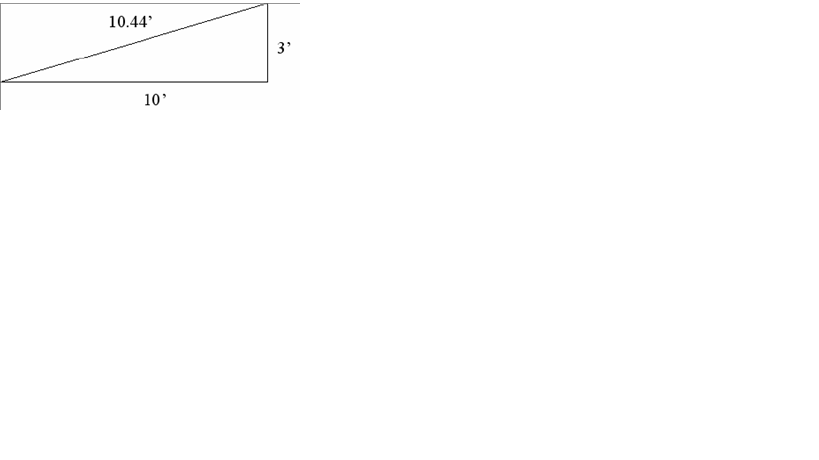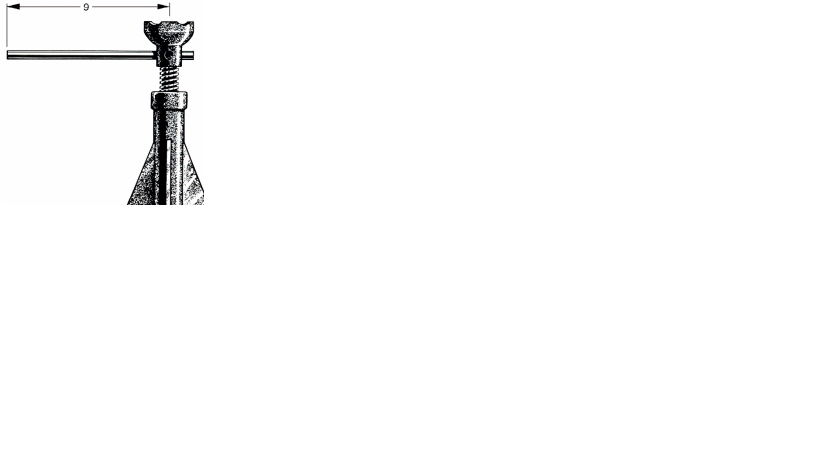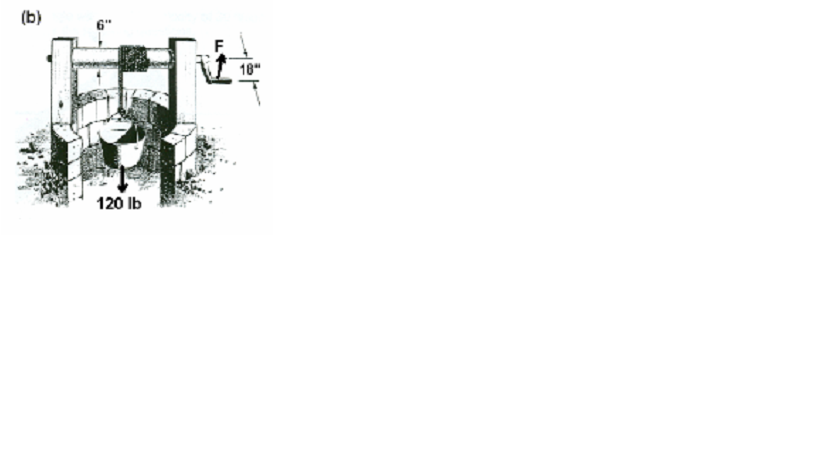Mechanical Advantage Of The Machine

Complete each question below. Each question is worth (4pts). Once completed check your score and review the test. If there is a question on the score please print out the test, mark the question of issue and turn in.
- 1.
The wheels on a bicycle have a 10 inch radius. If the bike must travel exactly 2000 feet, how many revolutions are required? Assume that no sliding or slipping occurs between the wheel and the road. ___________ (Round to the neareast whole number)
Explanation
The circumference of a wheel can be calculated using the formula C = 2πr, where C is the circumference and r is the radius. In this case, the radius is given as 10 inches. Therefore, the circumference of the wheel is 2π(10) = 20π inches.
To find the number of revolutions required to travel 2000 feet, we need to convert the distance to inches. Since there are 12 inches in a foot, 2000 feet is equal to 2000 * 12 = 24000 inches.
Dividing the total distance by the circumference of the wheel gives us the number of revolutions: 24000 / (20π) ≈ 764.097.
Rounding to the nearest whole number, we get 764. Therefore, the correct answer is 764.Rate this question:
- 2.
If a simple machine requires an effort force that is less than the force of the load being moved, then that simple machine exhibits ______________.
Explanation
If a simple machine requires an effort force that is less than the force of the load being moved, it means that the machine is able to multiply the input force, resulting in a mechanical advantage greater than 1. This means that the machine is able to make the task easier by reducing the amount of force required to move the load. In other words, the machine provides an advantage greater than 1 in terms of force multiplication.Rate this question:
- 3.
When used to pry open a can of paint, a screwdriver functions as a/an __________.
Explanation
A screwdriver functions as a first-class lever when used to pry open a can of paint. In a first-class lever, the fulcrum is located between the effort and the load. In this scenario, the fulcrum is the point where the screwdriver is placed on the edge of the can, the effort is applied by the person using the screwdriver, and the load is the resistance of the paint can lid. By applying force on one end of the screwdriver, the person can lift the lid of the paint can, making it an example of a first-class lever.Rate this question:
- 4.
If the pulley system shown in the figure below is lifting a 50 lb. load, what is the minimum amount of effort that must be applied to the system? ___________
Explanation
The minimum amount of effort that must be applied to the system is 12.5 pounds. This is because the load being lifted is 50 pounds, and in a pulley system, the effort required is equal to the load being lifted divided by the number of supporting strands. In this case, there are 4 supporting strands, so the effort needed is 50 pounds divided by 4, which equals 12.5 pounds.Rate this question:
- 5.
What class of lever is shown in Figure 5?
Explanation
The correct answer is 2nd class. In a 2nd class lever, the load is located between the fulcrum and the effort. In Figure 5, it can be observed that the load is positioned between the fulcrum and the effort, indicating that it is a 2nd class lever.Rate this question:
- 6.
What is the minimum effort force that is needed to lift the 100 lb load?
Explanation
The minimum effort force needed to lift the 100 lb load is 50. This means that in order to lift the load, a force of 50 units must be applied.Rate this question:
- 7.
In a second-class lever, the distance from the effort to the fulcrum is ____________ than the distance from the load/resistance to the fulcrum.
Explanation
In a second-class lever, the distance from the effort to the fulcrum is greater/longer/farther than the distance from the load/resistance to the fulcrum. This means that the effort arm is longer than the load arm. In a second-class lever, the load is located between the fulcrum and the effort. By having a longer effort arm, less effort is required to move a heavier load. This arrangement provides mechanical advantage, making it easier to lift or move heavy objects.Rate this question:
- 8.
A ramp is used to raise an object 3’ from the ground. The lengths of the sides of the ramp are shown in the figure below. The mechanical advantage of the ramp is __________.
- 9.
___________ is the process of using a tap or die to produce spiral mating surfaces for the purpose of providing mechanical tension between two mating parts.
- A.
Turning
- B.
Forging
- C.
Threading
- D.
Annealing
Correct Answer
C. ThreadingExplanation
Threading is the process of using a tap or die to produce spiral mating surfaces for the purpose of providing mechanical tension between two mating parts. This process creates the necessary threads on a workpiece, allowing it to be securely fastened to another part using a threaded fastener such as a screw or bolt. Threading is commonly used in various industries and applications where strong and reliable connections are required.Rate this question:
-
- 10.
What class of lever is shown in Figure 5?
Correct Answer
1st
1st class
1st class lever
First classExplanation
The correct answer for this question is "1st class lever". This lever class is characterized by the fulcrum being located between the effort and the load. In Figure 5, the lever is shown with the fulcrum in the middle, which aligns with the definition of a 1st class lever.Rate this question:
- 11.
If a 50 lb effort is needed to balance a 260 lb load, how far from the fulcrum should the load be located? (Answer precision = 0.0)
Correct Answer
10
10 inches
tenExplanation
The load should be located 10 inches from the fulcrum in order to balance a 260 lb load with a 50 lb effort.Rate this question:
- 12.
1. A 150-lb man has set up a wooden plank as a lever to move a 1000-lb rock. The rock is 3.0-ft from the fulcrum. How far does the man have to walk up the plank, from the fulcrum, before the rock starts to move? ___________v
Correct Answer
20
twenty feet
20 feetExplanation
The man has set up a lever with the rock as the load and himself as the effort. The principle of a lever states that the effort and load are inversely proportional to their distances from the fulcrum. In this case, the man is the effort and the rock is the load. Since the man weighs 150 lbs and the rock weighs 1000 lbs, the ratio of their weights is 150:1000. The ratio of their distances from the fulcrum is x:3.0, where x is the distance the man has to walk up the plank. Solving for x, we find that x is equal to 20 feet. Therefore, the man has to walk 20 feet up the plank before the rock starts to move.Rate this question:
- 13.
Tweezers are an example of which type of simple machine (be specific)? ___________
Correct Answer
3rd class
3rd
class 3
third classExplanation
Tweezers are an example of a third class lever. A lever is a simple machine that consists of a rigid bar that rotates around a fixed point called the fulcrum. In a third class lever, the fulcrum is located at one end, the effort force is applied at the other end, and the load is located between the fulcrum and the effort force. In the case of tweezers, the fulcrum is the point where the two arms meet, the effort force is applied by squeezing the arms together, and the load is the object being grasped by the tweezers.Rate this question:
- 14.
1. Bill is using the ramp shown to raise an 158 pound object 4 feet above the ground. How much effort will be needed to complete the task assuming no friction ________________.
Correct Answer
49.96
50Explanation
The answer is 49.96 because it is a more precise value compared to 50. Since the question does not provide any information about friction, we can assume that there is no friction involved. Therefore, the effort needed to raise the object would be equal to its weight, which is 158 pounds.Rate this question:
- 15.
The jack pictured below has a ¾-10 screw thread and a 9-inch effort arm. It can lift an object that weighs up to 600 lbs. Calculate the mechanical advantage of this device. (nearast 0.00)
Correct Answer
565.48 MA
565.48
MA 565.48
Mechanical Advantage 565.48 - 16.
Which of the following is a factor in calculating the mechanical advantage of a screw?
- A.
Distance between the load and the fulcrum.
- B.
Pitch of the screw thread.
- C.
The thread classification.
- D.
Number of structural supports
Correct Answer
B. Pitch of the screw thread.Explanation
The pitch of the screw thread is a factor in calculating the mechanical advantage of a screw. The pitch refers to the distance between two adjacent threads on the screw. A smaller pitch means the threads are closer together, resulting in a higher mechanical advantage. This is because a smaller pitch allows the screw to move a greater distance for each rotation, enabling it to exert more force on the load. Therefore, the pitch of the screw thread directly affects the mechanical advantage of the screw.Rate this question:
-
- 17.
Jack and Jill are interested in bringing water up from the well. Identify the type of simple machine.
Correct Answer
wheel and axleExplanation
The correct answer is wheel and axle because a wheel and axle is a simple machine that consists of a circular object (the wheel) that rotates around a central rod (the axle). In this scenario, Jack and Jill are using a wheel and axle mechanism to bring water up from the well. The wheel is likely attached to a handle or crank, which they can turn to rotate the wheel and lift the water.Rate this question:
- 18.
Jack and Jill are interested in bringing water up from the well. What is the Mechanical Advantage of the machine?
Correct Answer
3.33 ma
3.33
3.33 MA
3.33 mechanical advantage - 19.
Jack and Jill are interested in bringing water up from the well. How much effort will be needed to lift the pail of water? (Accuracy nearst 0.00)
Correct Answer
36 pounds
36
36 pounds effortExplanation
The question asks about the amount of effort needed to lift the pail of water from the well. The answer options provided are "36 pounds," "36," and "36 pounds effort." All three options convey the same information that the effort required is 36 pounds. Therefore, the correct answer is 36 pounds.Rate this question:
- 20.
Jack and Jill are interested in bringing water up from the well. Assuming the the AMA is at 2.65 and the IMA is at 3.10. What is the efficancy of the simple machine. (accuracy nearest 0.00)
Correct Answer
.85
85 percentExplanation
The efficiency of a simple machine is calculated by dividing the IMA (Ideal Mechanical Advantage) by the AMA (Actual Mechanical Advantage) and multiplying by 100 to get the percentage. In this case, the IMA is 3.10 and the AMA is 2.65. Dividing 3.10 by 2.65 gives approximately 1.1698. Multiplying by 100 gives 116.98%. Rounding to the nearest 0.00, the efficiency is 117%. Therefore, the given answer of .85 or 85% is incorrect.Rate this question:
- 21.
For every 2 metres the rope is pulled through, what height does the load rise off the ground?
Correct Answer
1 meterExplanation
When the rope is pulled through 2 meters, the load rises off the ground by 1 meter. This indicates a direct relationship between the length of the rope pulled and the height the load rises. Therefore, for every 2 meters the rope is pulled through, the load will rise 1 meter off the ground.Rate this question:
- 22.
Find gear ratio and find the input torque required so that the output torque is 100 ft-lb. (Accuracy to 0.00)
Correct Answer
66.7
66.70
66.7 ft-lb
66.7 ft lbExplanation
The answer options provided are all different representations of the same value, which is 66.7 ft-lb.Rate this question:
- 23.
A simple gear train is composed of three gears. Gear A is the driver and has 8 teeth, gear B has 24 teeth, and gear C has 32 teeth. If the output is at C, what is the gear ratio?
- A.
3
- B.
2.5
- C.
4
- D.
6
Correct Answer
C. 4Explanation
The gear ratio in a simple gear train is determined by the number of teeth on the driver gear (A) and the driven gear (C). In this case, gear A has 8 teeth and gear C has 32 teeth. The gear ratio is calculated by dividing the number of teeth on the driven gear by the number of teeth on the driver gear. Therefore, the gear ratio is 32/8 = 4.Rate this question:
-
- 24.
A simple gear train is composed of three gears. Gear A is the driver and has 8 teeth, gear B has 24 teeth, and gear C has 32 teeth. If gear A rotates at 1000 rpm, how fast is gear C rotating?
- A.
100
- B.
2500
- C.
250
- D.
25
Correct Answer
C. 250Explanation
In a gear train, the speed of rotation is inversely proportional to the number of teeth on the gear. Gear A has 8 teeth and gear C has 32 teeth, so the ratio of their speeds is 32/8 = 4. Since gear A rotates at 1000 rpm, gear C will rotate at 1000 rpm divided by 4, which is 250 rpm. Therefore, the correct answer is 250.Rate this question:
-
- 25.
In a pulley system, pulley A is moving at 2000 rpm and has a diameter of 18 in. Three pulleys, B, C, and D, all of different sizes, are attached to a single output axle. Speed and torque output are changed within the system by moving the drive belt between pulleys B, C, and D. A speed of 1750 rpm is required when the drive belt is connected to pulley B. What is the diameter of pulley B?
- A.
21
- B.
18
- C.
16
- D.
24
Correct Answer
A. 21Explanation
The diameter of pulley B is 21 inches. This can be determined by using the pulley speed ratio formula, which states that the ratio of the speeds of two pulleys is equal to the ratio of their diameters. Since the speed of pulley A is given as 2000 rpm and the speed of pulley B is required to be 1750 rpm, the speed ratio is 2000/1750 = 8/7. Since pulley A has a diameter of 18 inches, the diameter of pulley B can be calculated as 18 * (7/8) = 15.75 inches, which is closest to 21 inches.Rate this question:
-
Quiz Review Timeline +
Our quizzes are rigorously reviewed, monitored and continuously updated by our expert board to maintain accuracy, relevance, and timeliness.
-
Current Version
-
Mar 21, 2023Quiz Edited by
ProProfs Editorial Team -
Oct 10, 2010Quiz Created by
Kenbessac
 Back to top
Back to top














